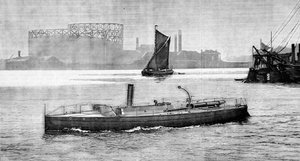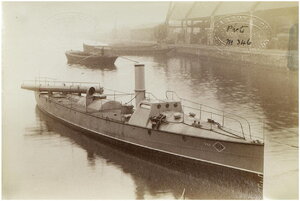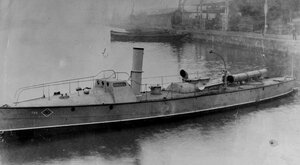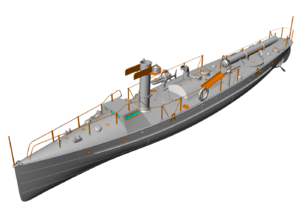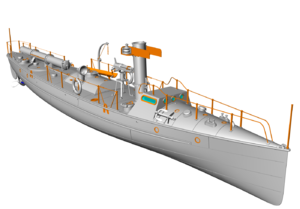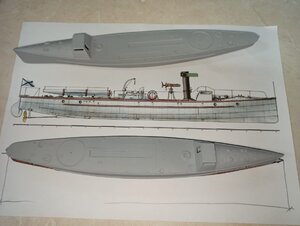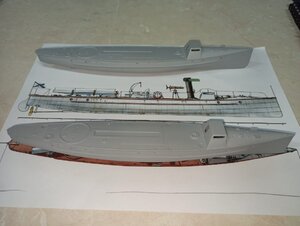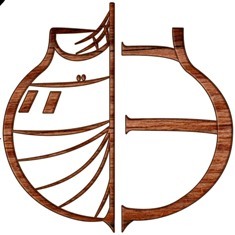Latest news from The squadron.
A little history, screenshots and photos of the test build
60ft Torpedo Boat YARROW
October 1894: The aluminium torpedo boat
By
Stuart Nathan 30th September 2015 12:03 pm
A wonder of its day, the first aluminium military vessel, a torpedo boat, caused a quiet stir when it appeared in the Thames. But the wonder-metal had later problems
A visit to Engineer Towers 110 years ago would have caught our predecessors in a state of excitement most atypical of the Victorian gentlemen. London was aflap, it seems, over the exhibition of a boat in the Thames which appeared to defy the norms of military craft design. As yet unnamed, this was a torpedo boat which a Poplar-based shipbuilder called Yarrow & Co had built for the French Navy. “Ten tonnes with steam up and coal in the bunkers; twenty and a half knots speed; 300 horsepower. Ten years ago — perhaps five years ago — the man who suggested the possibility of producing a boat which could live in a sea and satisfy the conditions embodied in the lines above would have been regarded as a lunatic by those who had not watched the progress of events,” the journal expounded breathlessly.
Our Victorian artist’s impression of the aluminium torpedo boat demonstration
The boat’s secret was that it was made from aluminium; indeed at 60ft (18.2m) long and 9ft3in (2.8m) across the beam it was not only the largest aluminium ship ever made at that point, it was the largest aluminium structure of any kind.
Аluminium was by no means a new material in 1894; it had first been isolated in 1825. But it had long been something of a curiosity. It was so difficult to produce in the 1850s and 60s that it was more valuable than gold, and in 1884 the largest piece ever cast was installed as the capstone for the Washington Monument in the US (it weighed 2.8kg, and 30g of the metal cost more than an average day’s wages). In 1893 the first ever cast aluminium sculpture was installed in London; it’s still there, in Piccadilly Circus (universally known as Eros, even though it’s actually called The Angel of Christian Charity and was never intended to depict Eros). But even that isn’t large, so for a whole boat to appear a mere year later made from this fabled lightweight metal must have been a curiosity indeed.
The vessel was a second-class torpedo boat, a type designed to be carried on the deck of a larger warship and launched at need, so lightweight construction was a necessity.
The Engineer reported that Yarrow had carried out extensive tests on aluminium, whose structural properties were then little known; and had determined that to increase its tensile strength it had been determined hat it was best alloyed with 6 per cent of copper. The article states that the hull weight was two tons; about half that of a comparable steel boat; moreover, the beam was 9inches wider than a British 60ft boat. It had cost about £1000 more than a steel boat (which an online calculator tells us is a little under £91,000 in today’s money) but was 3.5knots faster. It was also extraordinarily quiet: ‘On Saturday she was run at a variety of speeds from dead slow up to the highest available, and at none was the slightest vibration to be felt in any part of the boat forward, aft or amidships,” it noted: . “The only species of the kind was a sort of purring thrill.” While steel magnified every sound on a boat, aluminium seemed to deaden it: “The new metal acting very much like wood.” This would give it unheard-of stealth opportunities, it added.
The Engineer proclaimed the boat “the best torpedo boat of the size that has ever been produced.” Later reports are patchy; it appears that it was named La Foudre and some reports suggest that it suffered from corrosion. In any case, the use of aluminium was adopted by Navies worldwide as a superstructure material, but this was relatively shortlived. The metal does not respond well to heat; despite its perception as a relatively inert material, it is highly chemically reactive in in the wrong circumstances highly flammable. Moreover, at high temperatures it loses strength rapidly. The US Navy stopped using it for superstructure after a missile cruiser called USS Belknap collided with an aircraft carrier in 1975 and caught fire, with its superstructure being completely destroyed. Although it is sometimes reported that the Royal Navy’s HMS Sheffield, which sunk during the Falklands war in 1982, burned because it was made of aluminium, this is in fact not true: Sheffield had all-steel hull and superstructure, and the fire which doomed it resulted from an Exocet missile damaging its firefighting systems. The Royal Navy in fact also abandoned aluminium structure in the 1970s after several shipboard fires.
When the Whitehead torpedo was introduced it was at once seen that for boat attack it had enormous advantages over the old method of carrying a tin of explosive at the end of a pole. The ship need not be approached within 600 yards, and thus the operation was not one of such great hazard. But any chance of success and escape afterwards would be much increased if it were possible to command in the boat very high speed, so as to reduce the time during which the boat would be under fire in its approach or retreat. Such a consideration led to the development of the high speed torpedo boats which we now see in the hands of nearly every nation. At first it was thought a boat about 80 ft long would answer all requirements, and Russia in 1877 constructed a hundred boats 75 ft. long and 10 ft. beam. The size was such that they could be transported from the Baltic to the Black Sea by rail. Mr Yarrow, the eminent torpedo boat builder on the Thames, supplied some sets of machinery and drawings from which other sets could be made in Russia. The first of these boats tried on the Neva had a speed of 18 knots. This was a great advance in a boat of such dimensions.
